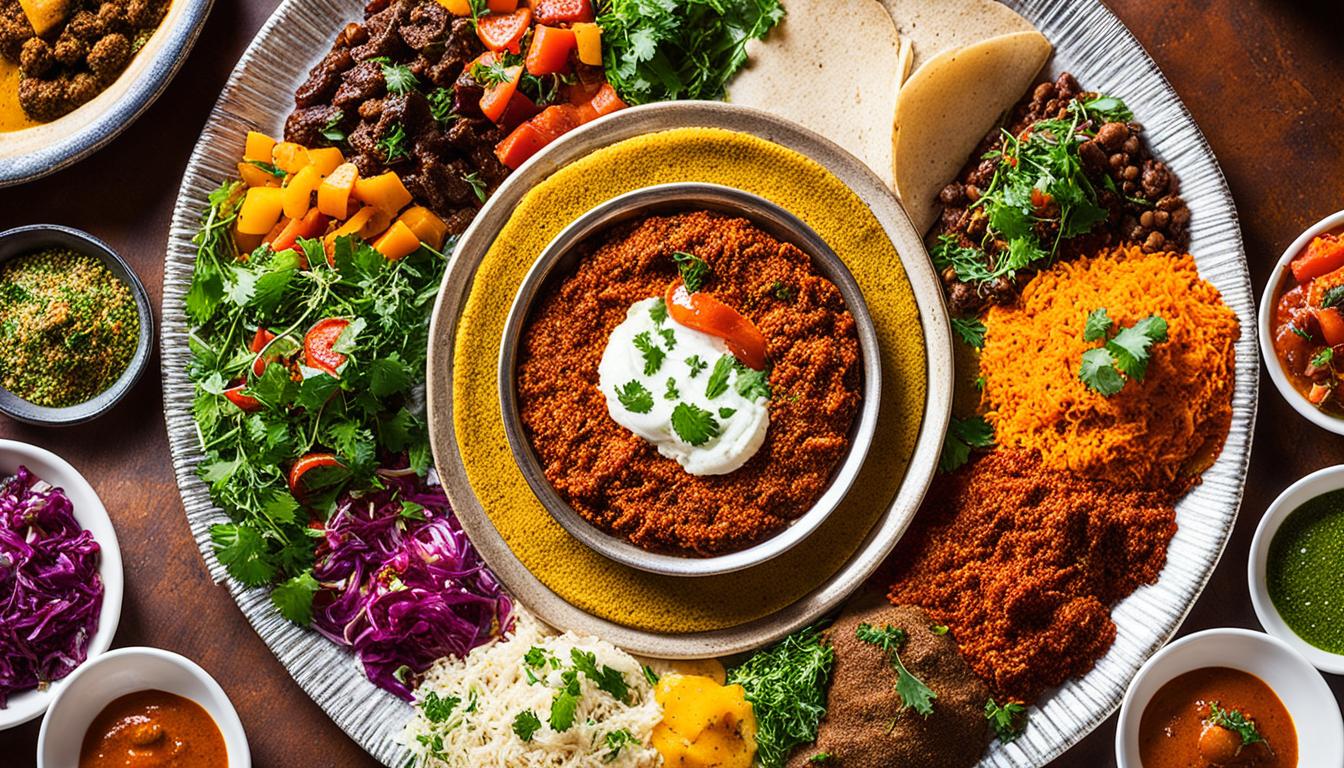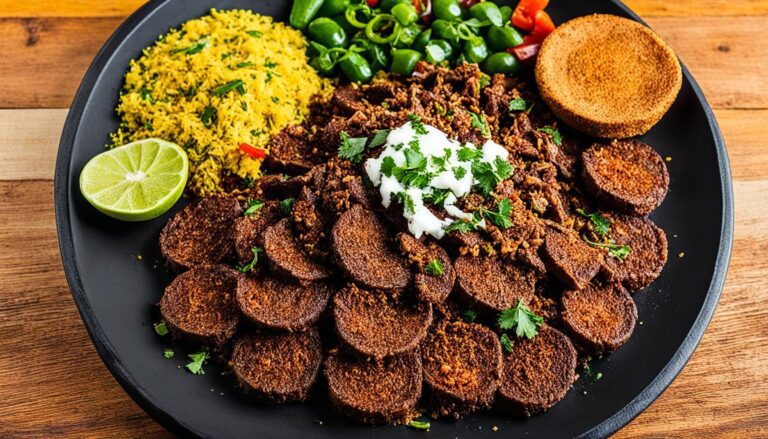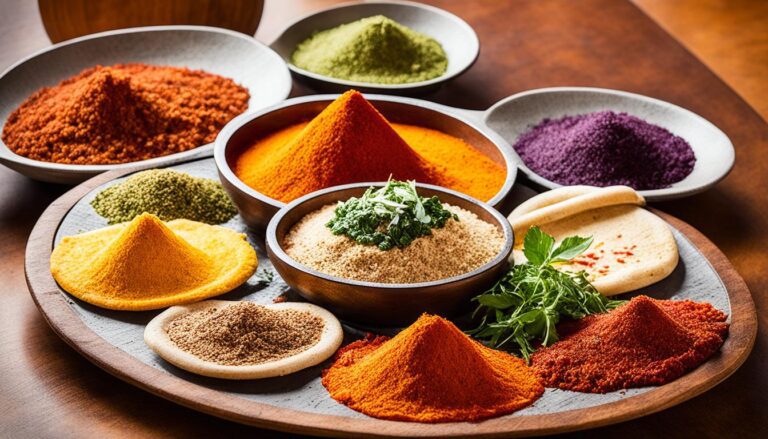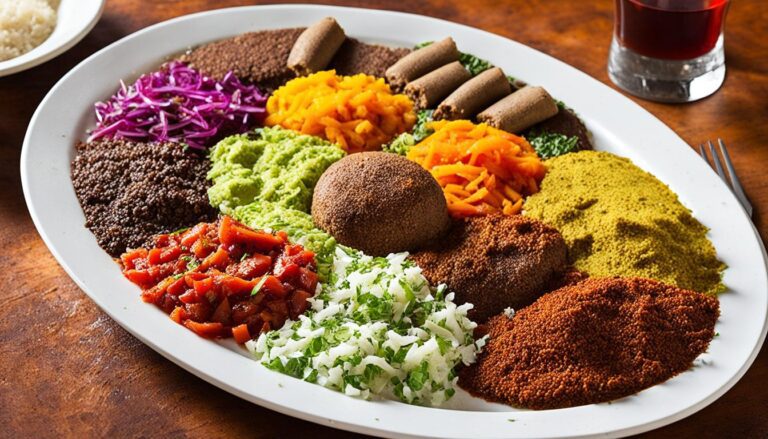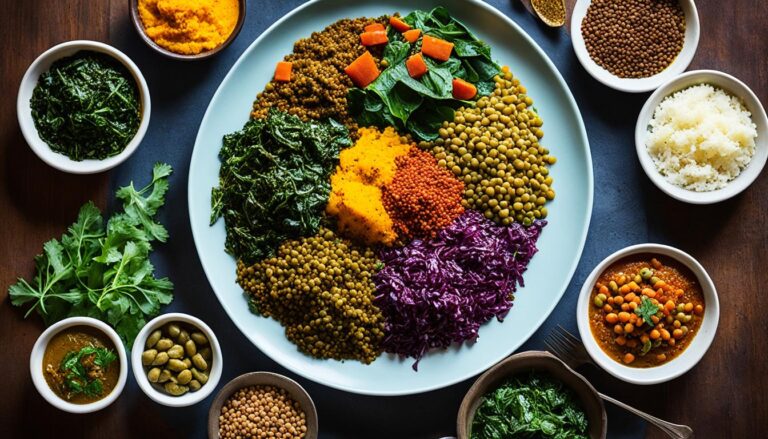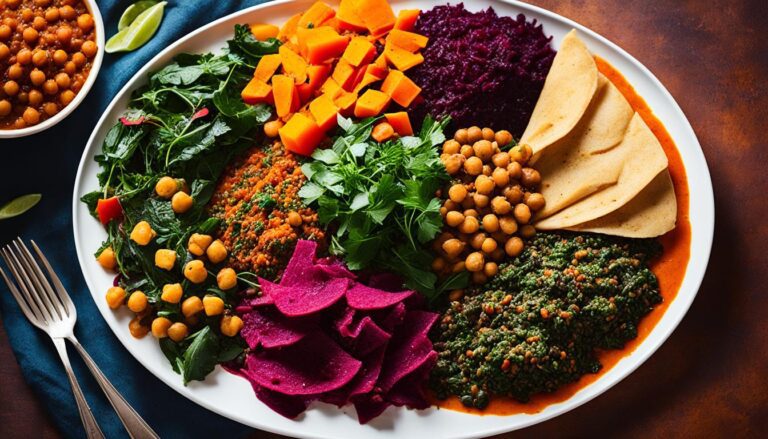What Is Ethiopian Food Called?
When it comes to exploring new cuisines, Ethiopian food has become a popular choice among food enthusiasts worldwide. But have you ever wondered what Ethiopian food is actually called? Let’s dive into the vibrant world of Ethiopian cuisine and discover the answer.
Key Takeaways:
- Ethiopian cuisine is known for its unique and flavorful dishes.
- The traditional Ethiopian bread, injera, is a staple in Ethiopian meals.
- Spices like berbere add bold and distinctive flavors to Ethiopian food.
- Communal dining and the coffee ceremony are integral parts of Ethiopian food culture.
- Exploring Ethiopian cuisine is a journey of flavors and cultural immersion.
The Essence of Ethiopian Cuisine
One of the defining features of Ethiopian cuisine is the use of spices. Berbere, a spice mix containing chile pepper, fenugreek, ginger, cardamom, and cinnamon, is a common seasoning used in many Ethiopian dishes. The combination of these spices creates a unique and flavorful taste that is both aromatic and bold.
Accompanying these delicious flavors is the traditional Ethiopian bread, injera. Made from fermented teff flour, injera is a sourdough flatbread that serves as the foundation of most meals. Its slightly tangy taste and spongy texture make it the perfect companion to the rich and savory Ethiopian dishes.
However, Ethiopian cuisine is not just about the food itself; it is also about the experience of dining together. Communal dining is deeply ingrained in Ethiopian culture, where people gather around a large tray of injera and share a variety of dishes placed on top. This creates a sense of unity and togetherness, making the dining experience more than just a meal but a celebration of community.
Traditional Ethiopian Dishes You Must Try
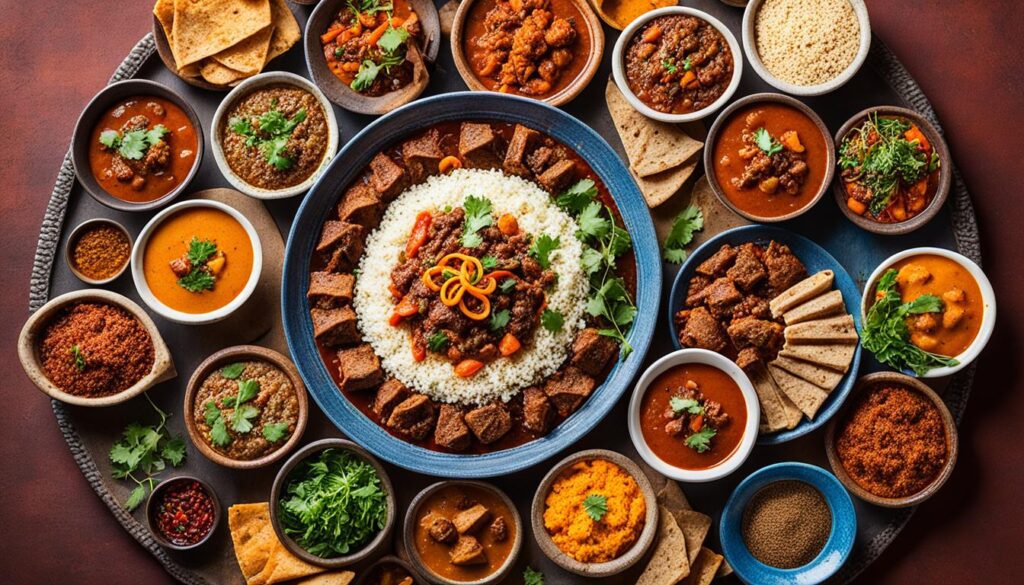
When it comes to Ethiopian cuisine, there is a wide variety of dishes that are a must-try for any food enthusiast. These traditional Ethiopian dishes showcase the diversity and complexity of the cuisine, offering a burst of flavors and textures that are sure to leave you satisfied.
Tibs
One such dish is tibs, a savory and flavorful pan-fried beef or lamb dish. Seasoned with a blend of Ethiopian spices, tibs is cooked to perfection and served with injera, the traditional Ethiopian bread. The combination of tender meat and aromatic spices creates a mouthwatering experience that is hard to resist.
Kitfo
If you’re feeling more adventurous, kitfo is a dish that shouldn’t be missed. Made from minced raw beef mixed with spiced butter, kitfo delivers a unique and bold flavor that is unlike anything else. Served with injera and accompanied by various condiments, this dish is known for its rich taste and melt-in-your-mouth texture.
Beyaynetu
For those looking for vegetarian options, beyaynetu is the perfect choice. This combination platter features an array of vegetable curries, lentil stews, and other flavorful dishes. From spicy lentils to hearty greens, beyaynetu offers a delicious and satisfying dining experience for vegetarians and meat-lovers alike.
To truly appreciate the beauty and complexity of these dishes, they should be enjoyed with friends and loved ones. Ethiopian cuisine is known for its communal dining culture, where everyone gathers around a shared platter, tearing off pieces of injera and delighting in the array of flavors. The sense of unity and togetherness that comes from sharing a meal is an integral part of the Ethiopian dining experience.
So whether you’re a fan of meat dishes like tibs and kitfo or prefer the vibrant flavors of beyaynetu, exploring the world of Ethiopian cuisine is an adventure you won’t want to miss.
Ethiopian Food and Flavors
The flavors of Ethiopian food are a fusion of earthy, spicy, tart, sour, and pungent tastes. The combination of these flavors creates a unique and vibrant taste experience that sets Ethiopian cuisine apart from other culinary traditions.
One key element that contributes to the distinct flavors of Ethiopian food is the berbere seasoning. Made with a blend of spices including chile peppers, fenugreek, cinnamon, ginger, cardamom, and coriander, berbere adds a bold and aromatic kick to many Ethiopian dishes. Its earthy and spicy notes complement the other ingredients and enhance the overall flavor profile.
Another characteristic flavor in Ethiopian cuisine is the tartness and sourness that comes from fermented ingredients. Injera, the sourdough flatbread that accompanies most meals, is made with fermented teff flour and imparts a tangy flavor to each bite. It serves as a wonderful contrast to the rich and savory stews and curries.
Pungent flavors also play a significant role in Ethiopian cuisine. The use of ingredients such as garlic and onions adds depth and intensity to the dishes, creating a memorable dining experience. These flavors, combined with the aromatic spices and herbs, make each bite a delightful and flavorful journey.
Experience the captivating flavors of Ethiopian food and let your taste buds explore the diversity of earthy, spicy, tart, sour, and pungent sensations. Whether you are enjoying the traditional tibs, the fiery doro wat, or the flavorful vegetarian options, you’ll be treated to a culinary adventure like no other.
Ethiopian Cuisine: A Brief History
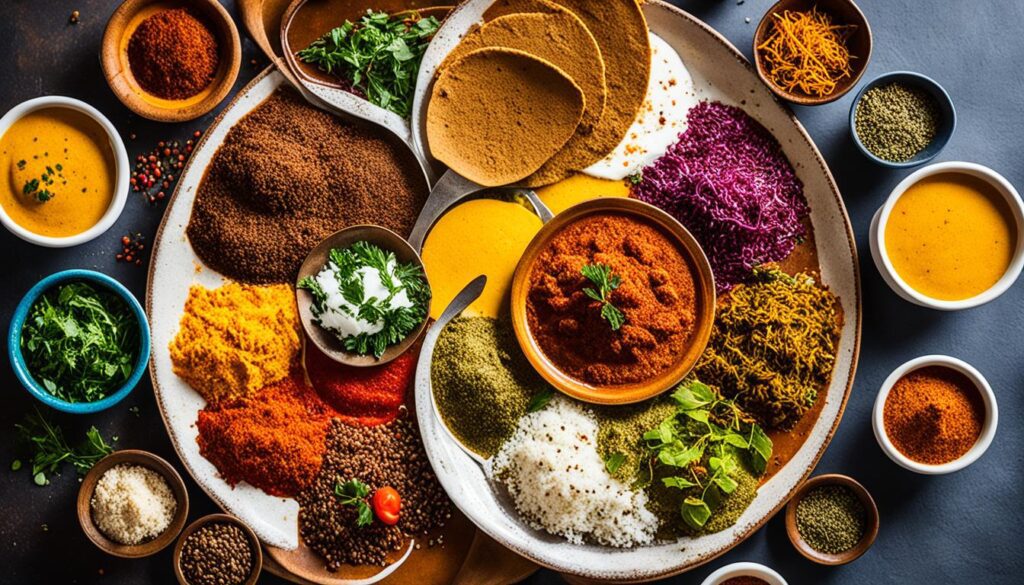
Ethiopian cuisine has a rich history that spans centuries, evolving from a culmination of diverse influences and indigenous ingredients. The region of modern-day Ethiopia has long been a hub for spice trade, resulting in a vibrant culinary tradition steeped in flavors from around the world.
The spice trade brought a myriad of exotic flavors to Ethiopia, with influences from India, Portugal, and East Asian countries. Spices such as ginger, chile peppers, and a blend of aromatic spices were introduced, creating a harmonious fusion with the country’s native ingredients.
In addition to the spices, indigenous grains played an essential role in shaping Ethiopian cuisine. Sorghum, millet, teff, and wheat are grains that thrive in the Ethiopian climate and are widely used in various dishes. These grains provide a hearty and nutritious base for many traditional Ethiopian meals.
Over time, Ethiopian cuisine has developed into a unique amalgamation of introduced spices and indigenous grains, resulting in a tapestry of flavors that captivate the palate. The combination of exotic spices and homegrown ingredients gives Ethiopian dishes their distinct taste and aroma.
The rich history of Ethiopian cuisine is a testament to the country’s cultural heritage and the legacy of the spice trade. The blend of flavors, influenced by spices from various corners of the world and complemented by native grains, has created a culinary tradition that is cherished and celebrated both locally and globally.
The Cultural Significance of Ethiopian Food
Ethiopian food culture is deeply rooted in the country’s history and traditions. One of the key aspects of this culture is communal dining, which plays a significant role in Ethiopian society. Communal dining emphasizes the importance of sharing meals and fosters a sense of community and togetherness.
In Ethiopian households, it is common for family members and friends to gather around a large tray of injera, the traditional Ethiopian bread, and share a variety of dishes placed on top. This communal dining experience creates a strong bond among individuals, as they come together to enjoy the delicious flavors and engage in meaningful conversations.
The Ethiopian Coffee Ceremony
Another cultural tradition closely associated with Ethiopian food is the coffee ceremony. After a satisfying meal, the Ethiopian coffee ceremony takes place, a time-honored ritual that reflects the country’s love for coffee and hospitality.
The coffee ceremony is a ceremonial process that involves the preparation, brewing, serving, and enjoyment of coffee. It begins with the green coffee beans being roasted over hot coals, filling the air with a rich aroma. The roasted beans are then ground and brewed in a traditional clay coffee pot known as a jebena. The freshly brewed coffee is poured into small cups, and it is customary for the host to serve three rounds of coffee to each guest.
This coffee ceremony is more than just a way to enjoy a delicious cup of coffee; it symbolizes hospitality, friendship, and a warm welcome to guests. It is a cherished tradition that brings people together, and it showcases the Ethiopian people’s appreciation for the art of coffee preparation and the joy of communal gatherings.
Conclusion
Ethiopian cuisine is a true culinary delight that has gained immense popularity worldwide. Its unique flavors, rich history, and communal dining culture make it a favorite among both locals and international food enthusiasts. The diverse range of dishes, from spicy meat delicacies like tibs and kitfo to flavorful vegetarian options such as beyaynetu, offers something for everyone to enjoy.
Exploring Ethiopian cuisine is not just about savoring the delicious flavors, but also immersing oneself in the vibrant culture and traditions associated with the food. The communal dining experience, where friends and family gather around a shared tray of injera and enjoy a meal together, creates a sense of unity and togetherness.
As Ethiopian food continues to captivate taste buds around the world, there’s no better time to indulge in the delightful world of Ethiopian cuisine. So, grab your friends, head to the nearest Ethiopian restaurant, and embark on a culinary journey filled with unforgettable flavors and cultural immersion. Experience the popularity and charm of Ethiopian food for yourself, and you won’t be disappointed.

